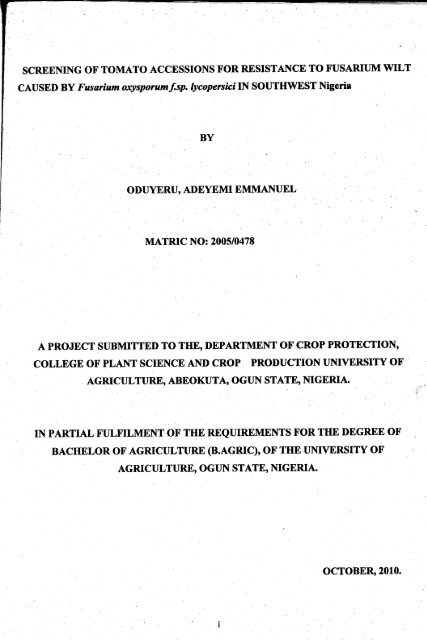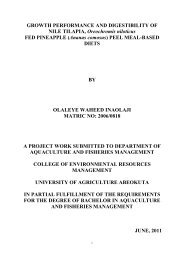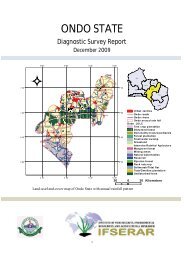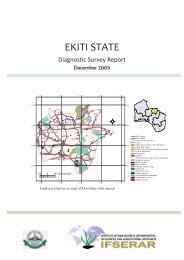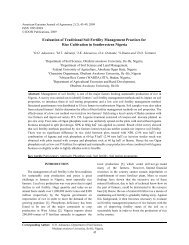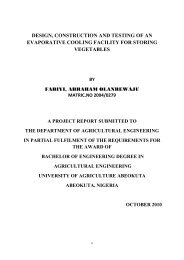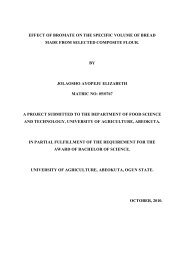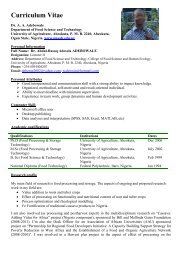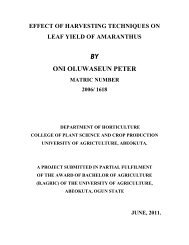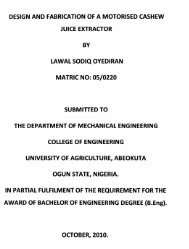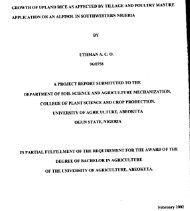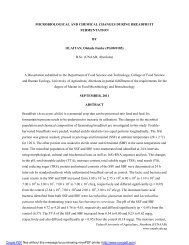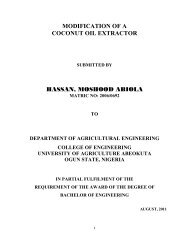SCREENING OF TOMATO ACCESSIONS FOR RESISTANCE TO ...
SCREENING OF TOMATO ACCESSIONS FOR RESISTANCE TO ...
SCREENING OF TOMATO ACCESSIONS FOR RESISTANCE TO ...
You also want an ePaper? Increase the reach of your titles
YUMPU automatically turns print PDFs into web optimized ePapers that Google loves.
<strong>SCREENING</strong> <strong>OF</strong> <strong><strong>TO</strong>MA<strong>TO</strong></strong> <strong>ACCESSIONS</strong> <strong>FOR</strong> <strong>RESISTANCE</strong> <strong>TO</strong> FUSARIUM WILT<br />
CAUSED BY Fusarium oxysporumj.sp. Iycopersici IN SOUTHWEST Nigeria<br />
A PROJECT SUBMITTED <strong>TO</strong> THE, DEPARTMENT <strong>OF</strong> CROP PROTECTION,<br />
COLLEGE <strong>OF</strong> PLANT SCIENCE AND CROP PRODUCTION UNIVERSITY <strong>OF</strong> .<br />
AGRICULTURE, ABEOKUTA, OGUN STATE, NIGERIA.<br />
IN PARTIAL FULFILMENT <strong>OF</strong> THE REQUIREMENTS <strong>FOR</strong> THE DEGREE <strong>OF</strong><br />
BACHELOR <strong>OF</strong> AGRICULTURE (B.AGIUC), <strong>OF</strong> THE UNIVERSITY <strong>OF</strong><br />
AGRICULTURE, OGUNSTATE, NIGERIA.
DEDICATION<br />
This project is dedicated to God Almighty, who has been my strength and helper throughout<br />
my<br />
undergraduate<br />
days in UNAAB.
My gratitude goes to our Lord Jesus Christ, the greatest provider, sustenance and giver of<br />
peace.<br />
My parents; Mr and Mrs. Oduyeru, I really appreciate you for your support, morally and<br />
financially,<br />
may you live long to eat the fiVit of your labour in Jesus name, Amen. My siblings<br />
Miss Temitope, Damilola, Busola, BiodUIl: and Segun, My Daddy (Mr Wale LawaI) for your<br />
fatherly support and Advice and my Big Uncles; Mr Deji Lawal, Mr Ranti Oduyeru and Mr<br />
Gboyega Okubanjo thanks for your understanding<br />
at all time.Also, to all_my immediate relatives,<br />
thanks for your support. We shall all live to see more of His goodness.<br />
To my supervisor: Dr. A.R Popoola, .thank you for your fatherly advice and for all the<br />
knowledge<br />
you imparted in me. I am really grateful. And not forgetting Mr. Ganiyu for your<br />
Advice and moral support throughout this project<br />
To my Head of Department;<br />
Dr Pitafi And to my lecturers, Dr. Atugun, Mr. Odeyemi, Dr.<br />
Ayo-John and Dr. Afolabi and to others that their names are not mentioned here, thank you sirs.<br />
To my project mates, in person of Lekan Davies, Kuponiyi Razak and Bimbola Adefolalu., God<br />
bless you all for your kind gesture all thr01,lgh. And not forgetting my friend and a brother from<br />
another mother in person of Adami Ayokunle, thanks a million. May our labour never be in vain.
The experiment<br />
was conducted to investigate the resistant level of tomato accessions to Fusarium<br />
wilt caused by Fusarium oxysporum f sp.Lycopersici. The experiment was a randomized<br />
complete block design (RCBD) consisting of 3 treatments with 3 replicates. Ten accessions were<br />
inoculated with samples of fungal strain 1 and strain 2 using Drenching method into the soil.<br />
Plant performance<br />
was based on plant height, number of leaves number of branches and number<br />
of tomato fruits. Disease assessment was based on disease severity, incidence and number of<br />
days for 50% wilt. The result obtained from the experiment shows that different variety has<br />
different resistant level to the disease which was evident in the plant height and number of fruits<br />
produced.NG/MRIMA Y/09/006 is resistant to strain 1 and susceptible to strain 2 of the Fusarium<br />
been inoculated into it and was able to produce the high number of fruits.<br />
This study could therefore suggest N GIM RIMA Y109/006 which has minimum mean severity<br />
(36.03%) and could produce reasonable number of fruit under the Fusarium wilt infection.
1.0 Introduction<br />
1.1 Tomato<br />
1.2 Botanical description<br />
1.3 Disease resistance<br />
1.4 Abiotic stress tolerance<br />
1.5 Objective<br />
1.6 Justification
1: Disease Severity scale<br />
2: Disease assessment oftomato accessions under infection and control<br />
3: Growth performance of tomato accessions.<br />
4: Yield parameter of Tomato accessions
Tomato (Lycopersicon escuientum Mill) is an important source of vitamin C,<br />
calories, phosphorus and calcium (Davis and Hobson, 1981; Langer and Hill, 1991).Worldwide,<br />
tomatoes are an important part of a diverse and balanced diet (Willcox et ai., 2003). It is estimated<br />
that over 62 800 accessions of the cultivated and wild species of tomato (mostly L. escuientum<br />
accessions) are maintained in genebanks around the world(Rossi et ai., 1998), Among the nine<br />
Lycopersicon species, only" L. escuientum has become a domesticated crop though L.<br />
pimpinellifolium (with fruit diameter -1 cm) is also casually planted for consumption(Rick,<br />
1978).The cultivated tomato has limited variability, largely because of several population<br />
bottlenecks in the forms of founder events and natural and artificial selections that occurred during<br />
domestication and evolution of modem cultivars(Rick, 1976),During the past 70 years wild species<br />
of tomato have been utilized in breeding programs to improve the cultivated tomato (Rick,.<br />
1979;.Rick, 1982), According tos (Rick, 1976), domestication of L. escuientum<br />
was accompanied<br />
by a transition from exerted to inserted stigmas, and consequently changing from facultative<br />
outcrossing to enforced inbreeding, It is not known exactly -when domestication of tomatoes<br />
occurred, however, by the time the Spanish conquered Mexico in 1523, they were already<br />
domesticated (Rick, 1978).
1.2 Botanical description<br />
Tomato belongs to the nightshade family Solanaceae, which is in division<br />
Magnoliophyta, class Magnoliopsida, subclass Asteridae, order Solanales, and suborder Solanineae<br />
(Knapp et al., 2004; Nee et al., 1991.). The extremely diverse and large Solanaceae family is<br />
believed to consist of 96 genera and over 2800 species in three subfamilies, Solanoideae (in which<br />
Lycopersicon belongs), Cestroideae, and Solanineae. Solanaceae is one of the most economically<br />
important families of angiosperms and contains many of the commonly ~ultivated plants, including<br />
potato, tomato, pepper, eggplant, petunia, and tobacco. This family is the most variable of all crop<br />
species in terms of agricultural utility, the 3rd most economically important crop family, exceeded<br />
only by the grasses and legumes, and the most valuable in terms of vegetable crops (Vander<br />
Hoeven, et al., 2002). Among all plant families, members of the Solanaceae are extremely diverse in<br />
terms of growth habit (from trees to small annual herbs), habitat (from deserts to the wettest tropical<br />
rain forest), and morphology (Knapp et al., 2004). Many Solanaceous species have played important<br />
roles as model plants, including tomato, potato, pepper, tobacco, and petunia. The tomato genus<br />
Lycopersicon is one of the smallest genera in Solanaceae, though the centerpiece in the family for<br />
genetic and molecular research. It is the closest to the genus Solanum (nightshade), an association<br />
which originally led people to believe tomato was poisonous (Rick, 1978). The cultivated tomato<br />
was originally named Solanum Iycopersicum by Linnaeus.(Linnaeus, 1953).<br />
Tomato is susceptible to over 200 diseases caused by pathogenic fungi, bacteria,<br />
viruses, or nematodes (Lukyanenko, 1991). Without question, the greatest contribution of modem<br />
plant breeding to tomato improvement has been through development of cultivars with improved<br />
disease resistance. Resistance has been identified, and in many cases characterized, for more than 30
of the major tomato diseases. Most commercial cultivars possess up to 6 (in true breeding lines) or<br />
10 (in hybrids) disease-resistance attributes. These mainly include diseases for which major<br />
resistance genes have been identified, including fusarium wilt, verticillium wilt, root-knot nematode,<br />
alternaria stem canker, gray leaf spot, and some bacterial and viral diseases. However, horizontal<br />
(a.k.a. field or polygenic) resistance has also been reported for several tomato diseases, where major<br />
genes for resistance to a particular pathogen or race are not found, such as early blight, powdery<br />
mildew, bacterial canker, and bacterial wilt. Except in a few cases, tomato wild species have been<br />
utilized as the source of resistance for all tomato diseases. Resistance resources have been identified<br />
in most related wild species of tomato, in particular 1. pimpinellifolium, 1. peruvianum, and 1.<br />
hirsutum. For some tomato diseases, such as late blight (caused by oomycete Phytophthora<br />
infestans) and powdery mildew (caused by fungus Oidium lycopersicum), both vertical and<br />
horizontal resistances have been identified.<br />
Although the cultivated tomato is widely adapted to different climates, its growth and<br />
development is rather sensitive to different environmental stresses, including salinity, drought,<br />
excessive moisture, extreme temperatures, mineral toxicity and deficiency, and environmental<br />
pollution. There is limited genetic variation for abiotic stress tolerance within the cultivated species<br />
and most commercial cultivars are considered moderately to highly sensitive to different stresses.<br />
Fortunately, sources of genetic tolerance (or resistance) to different abiotic stresses are found within<br />
the related wild species, including 1. chilense, 1. peruvianum, 1. pennellii, 1. pimpinellifolium, 1.<br />
hirsutum,1. cheesmanii, 1. chmielewskii, and 1. parviflorum (Foolad, 2005). In addition, there are a<br />
few species within Solanum that exhibit tolerance to environmental stresses and which may be<br />
utilized in tomato breeding for stress tolerance. Several tomato wild species have been utilized for
genetic and physiological characterization of abiotic stress tolerance and for breeding purposes<br />
(Scott, 1993), In addition, stress tolerance is a developmentally regulated, stage-specific<br />
phenomenon; tolerance at one stage of plant development is often not correlated with tolerance at<br />
other developmental stages (Asins et al., 1993; Foolad, 1999).<br />
1.5 Objective:<br />
To determine the resistance levels of different tomato varieties to Fusarium wilt<br />
disease caused by Fusarium oxysporum f<br />
sp. Iycopersici.<br />
1.6 Justification:<br />
Tomato varieties are susceptible to several diseases caused by pathogenic fungi,<br />
bacteria or viruses. Different c?ntributions of modem plant breeding to tomato improvement have<br />
been through development of cultivars with improved disease resistance. Hence the need to<br />
determine the resistance level of different varieties of tomato to Fusarium caused by Fusarium<br />
oxysporumfsp<br />
lycopersici wilt disease in South West Nigeria.
· .<br />
plant roots, but seem not to invade the vascular system (Olivain and Alabouvette 1997, 1999). The
However, there are indications for a certain F: oxysporum-strain<br />
specific effect of compounds<br />
found in tomato root exudates. In a recent study it was reported that the germination rate of several<br />
F. oxysporum strains is affected differently by tomato root exudates (Steinkellner et al., 2005).<br />
Moreover, studying the spore germination of a Fori strain and a biocontrol strain of F. oxysporum in<br />
tomato root exudates and two of its major known compounds, glucose and citric acid, (Bolwerk et<br />
al., 2005) found a higher stimulation for the biocontrol strain than for the pathogenic strain. In<br />
several studies it has been shown that root colonisation by symbiotic arbuscular-mycorrhizal fungi<br />
alters the root exudation pattern and thus the effect of the exudates on soil-inhabiting microbes<br />
(Lioussanne et al., 2003; Pinior et al., 1999; Sood, 2003). (Pinior et al., 1999) reported that root<br />
exudates from mycorrhizal plants affect the hyphal growth of arbuscular mycorrhizal fungi<br />
differently, compared to root exudates from non-mycorrhizal plants. Recently, (SchefIknecht et al.,<br />
2006, 2007) reported that root colonisation by an arbuscular-mycorrhizal fungus also affects the<br />
microconidial germination of the tomato pathogen F. oxysporum.<br />
2.2 Biology of Fusarium<br />
In solid media culture, such as potato dextrose agar (PDA), the different special forms<br />
of F. oxysporum<br />
can have varying appearances. In general, the aerial mycelium first appears white,<br />
and then may change to a variety of colors - ranging from violet to dark purple - according to the<br />
strain (or special form) of F. oxysporum.<br />
If sporodochia are abundant, the culture may appear cream<br />
or orange in color (Smith et al., 1988).<br />
F. oxysporum produces three types of asexual spores: microconidia, macroconidia, and<br />
chlarnydospores (Agrios, 1988).Microconidia are one or two celled, and are the type of spore most<br />
abundantly and frequently produced by the fungus under all conditions. It is also the type of spore
most frequently produced within the vessels of infected plants. Macroconidia<br />
gradually pointed and curved toward the ends. These spores are commonly<br />
are three to five celled,<br />
found on the surface of<br />
plants killed by this pathogen a
Due to the growth of the fungus within the plant's vascular tissue, the plant's water supply is greatly<br />
affected. This lack of water induces the leaves' stomata to close, the leaves wilt, and the plant<br />
eventually dies. It is at this point that the fungus invades the plant's parenchymatous<br />
tissue, until it<br />
finally reaches the surface of the dead tissue, where it sporulates abundantly (Agrios, 1988). The<br />
resulting spores can then be used as new inoculums for further spread of the fungus<br />
Due to prolonged survival in soil as a saprophyte and as resistant structures, F<br />
oxysporum is difficult to control (Mujeebur and Shahana, 2002; Borrero et al., 2004). Among control<br />
strategies available for Fusarium wilt management, soil fumigation and use of resistant cultivars are<br />
the most used. Biological control of plant pathogens using antagonistic<br />
fungal and bacterial strains is<br />
gaining increasing importance. Soil has untapped potential and contains several potential biocontrol<br />
agents (BCAs) such as Pseudomonas spp., Trichoderma spp. and non-pathogenic Fusarium spp. that<br />
have shown high antagonistic activity against several soil-borne pathogens (Fuchs et al., 1999;<br />
Ramamoorthy et aI., 2001). So far, several bacterial and fungal antagonistic strains have been shown<br />
to reduce the damage caused by different pathogens, including F oxysporum f. sp. Iycopersici<br />
(Postma and Rattink, 1992; Alabouvette, 200 I; Moretti et al., 2008).<br />
The best recommended<br />
way to control the disease is selecting resistant varieties of tomato (Silva and<br />
Bettiol, 2005). Recently there have been many reports about using bioactive compounds from<br />
biological control agents which were extracted from different fungi that inhibit many plant<br />
pathogenic fungi, including Fusarium wilt of tomato (Soytong, 1992). These bioactive compounds<br />
are Tricotoxin A50 extracted from Trichoderma harzianum PCO1; and Chaetoglobosin C extracted
from Chaetomium globusum that have been reported to elicit resistance or immunity in plants by<br />
inducing oxidative burst in plant cells (Nuchdonrong, et al., 2004; Soytong, 2002).<br />
So far, several bacterial and fungal antagonistic strains have been shown to reduce the damage<br />
caused by different pathogens, including F. oxy:sporum f. sp. Iycopersici (Postma and Rattink, 1992;<br />
Alabouvette, 2001; Moretti et al., 2008). Some studies have shown that the combined effect of<br />
antagonism and plant growth promotion by BeAs suppresses Fusarium wilt disease in several crops<br />
(De Boer et aI., 2003; Fahri and Murat, 2007).
The following ten accessions of tomato were used for the study:<br />
.
Dextrose Agar (PDA) and incubated at room temperature with the morphological<br />
characteristic of Fusarium been studied under compound microscope. F. oxysporum after<br />
incubation was purified by repeating sub-culture into fresh sterile media until pure culture<br />
were examined on the microscope. Propa!?ules was prepared in 100ml distilled water. The<br />
resultant suspension, with a concentration of 10 6 _10 7 propagules per ml was used to inoculate<br />
tomato plants 2wks after transplanting.<br />
3.5 Screenhouse experiment:<br />
The experiment was in completely randomized design with 3 replicates<br />
comprising of 90 space pots of accession's population maintaining intra and Inter spacing of<br />
0.5m and 1m within the pots. Platform comprising of bamboo were made,occupied by 10m<br />
by 5m land area space in which the pots was placed to avoid soil borne pathogen into the pot<br />
experimental<br />
pots.<br />
Cultural practices: wetting and weeding were regularly observed.<br />
Trans plan ting:<br />
Tomato seedlings of 4 wks old were transplanted into pots containing sterilized<br />
Tomato accessions = 10<br />
Fusarium strains = 2 most virulent + 1 control = 3
All data were subjected to analysis of variance (ANOYA) and mean were separated DMRT<br />
(Duncan Multiple Range Test)
% range scale Value<br />
1-20.0 1 Resistant (R)<br />
20.01-40.00 2 Mean resistant (MR)<br />
40.01-60.00 3 Mean susceptible (MS)<br />
60.01-80.00 4 Susceptible (S)<br />
~0.01-100.00 5 Highly susceptible (HS)<br />
Kavak and Boydak, 2006
The'result of the effect of Fusarium wilt on agronomic and yield parameters of the<br />
tomato accessions are presented in Table 2, 3, and 4. The number of branches, plant height and<br />
number of leaves per plant recorded in this study were as a result of their genetic resistance. The<br />
resistant accessions maintained their leaf numb~rs despite the Fusarium,wilt.<br />
Based on the number of leaves and plant height on Table (3), NG/MRIMA Y/09/005<br />
has 53.68cm for Strain 1 and 51.78cm for strain 2 while NG/MRIMAY/09l006<br />
has 54.88cm for<br />
strain 1 and 65.89cm for strain 2 and are more resistant to both strains of Fusarium inoculated and<br />
the accession that recorded the highest number of the leaves/plant is NG/MRIMA Y/09/006.<br />
Yield parameters such as number of fruits harvested were considered important<br />
indicators for the Fusarium wilt Table (4), in this study, the tomato fruits were harvested when they<br />
were firm and their colour fully developed. The number of fruit Iplant of the control is higher than<br />
the infected except in some cases which could be as a result of environmental factors, thus the<br />
Fusarium affects the number of fruitiplaI1t.NGIMRlMAY/09/006<br />
produces the highest number of<br />
fruit under infection, with strain 1 with having 4 and strain 2 with 2.67<br />
The incidence was compared among the varieties during the study on Table (2), both<br />
partially and incompletely wilted plant were encountered on the field, the result shows that the<br />
incidence of fusarium wilt on tomato is high in NGIMRIMA Y/09J005, having 3.50 to strain 1 and<br />
3.00 to strain 2 while NGIMRIMA Y/09/006 shows minimum resistance to the infection, having 2.33
to strain 1. A common feature on the fusarium wilt -on plant were collected from thO<br />
presence of varying degree of chlorosis.
ROMAROUND 2.67 ab 2.00 a 3.33 ab 45.03 ab 30.85 a 51.26 ab 48.33 a 45.00 a 46.00 a<br />
BESKE 2.67 ab 3.00 a 3.33 ab 45.00 a 44.83 a 52.13 ab 47.67 a 46.67 a 43.00"<br />
NG/M R/MAY/09/005 3.50 b 3.00" 2.67"b 57.10 b 46.00" 44.10 a 40.50" 47.33 a 52.00"<br />
NG/MR/MAY/09/006 2.33 ab 3.00" 4.00 b 36.76" 41.30 b 63.03 b 53.33 a 52.33 a 42.33 a<br />
NG/OE/MAR/09/019 2.67"b 3.00 a 3.33 ab 41.1 a 53.30 ab 49.53" 46.67" 44.67" 46.33 a<br />
PUREWATER 3.00"b 2.00 a 3.67 ab 53.65 a 33.75 b 64.06" 44.50" 56.00" 38.00 a<br />
SANTANA 2.00 a 1.50" 2.33 a 31.67" 26.00" 41.70"b 57.00" 60.50 a 53.67"<br />
NG/AO/MAY/09/011 2.00" 3.00 a 2.33 a 33.13 a 53.33"b 37.03" 56.00 a 44.33" 52.33 a<br />
NG/AA/MAY/09/030 3.50 b 2.33 a 3.00"b 53.35 ab 38.13" 48.60 ab 43.00 a 50.67" 46.33 a<br />
NG/TB/ AUG/09/006 2.00 a 3.00 ab 3.00 ab 48.80 a 48.80 a 49.83" 54.33" 45.67" 43.67"<br />
Means follow by a common letter in each column are not significantly difference by DMRT at P =<br />
0.05
TABLE 3: Growth performance of tomato accessions<br />
Accessions Plant height Number of Leaves number of branches<br />
51 52 CONTROL 51 52 CONTROL 51 52 CONTROL<br />
ROMAROUND 47.39" 31.96"b SS.40 b 8.22" 8.66 b 8.77" O.SO"b 0.15" 0.25"<br />
BESKE 35.55" 45.23" 60.S0~ 6.33" 7.89 b 8.44" 0.67" 0.25" 0.67"<br />
NG/MR/MAY/09/005 53.68" 51.78 bc S4.70 b 7.94 b 7.00 b 9.11" 0.33" 0.33" 1.00 b<br />
NG/MR/MAY/09/006 54.88" 65.89" Sl.30"b 7.56" 10.89" 8.67 b 0.33" 1.67"b 0.7S"b<br />
NG/OE/MAR/09/019 37.48" SS.OSb Sl.78"~ 6.00" 11.00" 7.SS b 1.00" 0.67"b 0.67"<br />
PUREWATER 38.76" 35.13"b 46.38"b 7.00 b 6.5S"b 7.5S b 0.33" 0.50" 1.00"b<br />
SANTANA 37.73" 25.23" 36.76" 7.44 b 5.67" 8.22" 0.25" 0.45" 1.00"b<br />
NG/AO/MAY/09/011 47.21" 44.07"b 38.93" 7.4S" 6.67"b 5.77" 0.33" 0.39" 0.33"<br />
NG/AA/MAY/09/030 41.15" 44.53"b 51.32"b 6.78 b 6.67"b 8.00" 0.45" 0.36" 0.33"<br />
NG/TB/ AUG/09/006 40.72" 44.76"b 44.6S"b 6.33 b 6.77 b 7.44" 0.35" 0.19" 0.33"<br />
Means follow by a common letter in each column are not significantly difference by DMRT at P =<br />
0.05
Table 4: Yield parameter of tomato accessions<br />
<strong>ACCESSIONS</strong> .<br />
Number of fruits<br />
$1 52 CONTROL<br />
ROMAROUND 2.67 3 0.50 3 2.67 3<br />
BESKE 1.00 3 2.00 3 3.33 3<br />
NG/MR/MAY/09/00S 1.33 3 2.00 3 3.33 3<br />
NG/MR/MAY /09/006 4.00 3 2.67 3 2.33 3<br />
NG/OE/MAR/09/019 0.67 3 2.00 3 1.67 3<br />
PURE WATER 1.33 3 0.67 3 2.33 3<br />
SANTANA 1.00 3 0.00 3 1.67 3<br />
NG/ AO/MAY /09/011 1.67 3 2.67 3 0.67 3<br />
NG/ AA/MAY /09/030 0.00 3 1.00 3 2.33 3<br />
NG/TB/ AUG/09/006 0.67 3 2.00 3 1.33 3<br />
Means follow by a common letter in each column are not significantly difference by DMRT at P =<br />
0.05
The tomato accessions were found to vary in their resistance to strain 1 and strain 2 of<br />
Fusarium oxysporumf<br />
sp. Lycopersici .This study shows that some diversity exists in the tomato<br />
accessions.<br />
Severity test for strain 1 shows that 7 varieties showed mean resistance while<br />
NGIANMAY/09/030, Pure wate~ and NG/MRIMAY/09/005 were susceptible. Maximum rating was<br />
3.5 on NG/MRIMAY/09/005 and NGIANMAY/09/030 when challenged with stain 1 on the field.<br />
Under field condition, many of the varieties that were grown were severely affected. Almost all<br />
varieties were susceptible to strain 2 of the inoculated Fusarium<br />
It is well documented<br />
that the occurrence of disease in plant was found to depend on at<br />
least two components: pathogen and its host plant; and for disease development requires favorable<br />
environmental<br />
condition. This study showed the different resistant level of the ten accessions to<br />
Fusarium wilt disease which is a soil borne disease.<br />
NG/MRIMA Y/09/006 exhibited minimum resistance in terms of disease severity,<br />
number of leaves and fruit yield, with its yield comparably<br />
high, which makes the variety as the<br />
best performing accessions used. It was observed from the data taken that all the tomato<br />
accessions inoculated with the fungi, fusarium oxysporum fsp .lycopersici shows the symptoms<br />
of Fusarium wilt, therefore the best way to control the disease is by planting under irrigation<br />
during the dry season
Based on this study, NG/MR/MA Y/09/006 is recommended in Fusarium wilt endemic<br />
field and also recommended is NG/AO/MAY/09/011 which is recommended based on high yield<br />
and the level of resistant to Fusarium wilt exercised by these varieties.
·<br />
different disease suppressive mechanism. Phytopathology 93:626-632
Fahri, Y., Murat D. (2007) Control of Fusarium wilt of tomato by combination<br />
of Fluorescent<br />
Pseudomonas, nonpathogen Fusarium and Trichoderma hazianum T22 in greenhouse<br />
condition. Plant Pathology Journal 6: 159-163.<br />
Foolad M.R. 1999, "Comparison of salt tolerance during seed germination and vegetative growth in<br />
tomato by QTL Mapping, "Gssenome. vol.42 no. 4, pp.727-734<br />
Foolad M.R. 2005, Breeding for abiotic stress tolerance in tomato," in Abiotic Stresses: Plant<br />
Resistance Through Breeding and Molecular Approaches, Ashraf M, and Harris P.J.C, Eds.,<br />
pp. 613-684, The Haworth Press, New Yor1
Olivain C. And Alabouvette C. (1999) Processes of tomato root colonization by a pathogenic strain of<br />
Fusarium oxysporum f.sp. lycopersici in comparison with a non-pathogenic strain. New<br />
phytologist, 141,497-510<br />
Olivain, C., and Alabouvette C. (1997) Colonizations of tomato root by a non-pathogenic strain of<br />
Fusarium. New Phytologist, 137,481-494.<br />
Olivain, C.,Humbert C.,Nahalkova J.,Fatehi J.,L'haridon F., and Alabouvette C. (2006).Colonization of<br />
tomato root by pathogenic and nonpathopgenic Fusarium oxysporum strains inoculated together<br />
and separately into the soil. ,Applied and Environmental Microbiology, 72, 1523-1531<br />
Pinior, A., Wyss D., Piche Y., and Vierheilig H. (1999) Plants colonized by AM fungi regulate further<br />
root colonization bt AM fungi through altered root exudation. Canadian Journal of Botany,<br />
77,891-897<br />
Postma J., Rattink H., 1992. Biological control of Fusarium wilt of carnation with a non pathogenic<br />
isolate of Fusarium oxysporum.<br />
Canadian Journal oj Botany 70: 1199-1205; Potato and<br />
Tomato; American Potato Journal; 74: 347 - 352<br />
Ramamoorthy, V., Raguchander T., Samiyappan R. (2001) Induction of systemic resistance by plant<br />
growth promoting rhizobacteria in crop plants against pests and diseases. Crop Protection 20: I-<br />
II<br />
Rick, C.M., (1979): "Potential improvement of tomatoes by controlled introgression of genes from wild<br />
species," in Proceedings aJthe ConJerence an Broadening the Genetic Base o.fCrops, pp. 167-<br />
173, Pudoc, Wageningen, The Netherlands.<br />
Rick, C.M., 1976, "Tomato, Lycopersicon esculentum ( Solanaceae)," in Evolution oj Crop Plants,<br />
Simmonds, N. W., Ed., pp.268-273, Longman ,London, UK.
Rick, C.M., 1982. "The potential of exotic gennplasm for tomato improvement," in plant improvement<br />
and Somatic Cell Genetics, Vasil, I. K. Scowcroft, W. R. and Frey, K. J., Eds., pp. 1-28,<br />
Academic Press, New York, NY, USA.<br />
Rossi, M., Goggin, F.L, Milligan, S.B., Kaloshian I., Ullman D.E. and Williamson V.M, 1998 "The<br />
nematode resistance gene Mi of tomato confers resistance against the potato aphid,"<br />
Proceedings of the National Academy of Sciences of the United States of America, vol. 95, no.<br />
17,pp.9750-9754<br />
Schelftknecht S.,Mammerler R., and Vierheilig H. (2005). Microoconida gennination of tomato<br />
pathogen Fusarium oxysporum<br />
in the presence of root exudates; Journal of Plant Interactions,<br />
1,23-30<br />
Schelftknecht, S.,Mammerler, R.,Steinkeller, S., and Vierheilig, H., (2006) Roots exudates of<br />
mycorrhizal tomato plants exhibit a different effect on microconidia gennination of Fusarium<br />
oxysporum f.sp. lycopersici than root exudates from non-mycorrhizal tomato plants.<br />
Mycorrhiza, 16,365-370<br />
Schelffknecht, S.,St- Arnaud M., Khaosaad T., Steinkeller, S., and Vierheilig H., (2007). An altered<br />
root exudation pattern through mycorrhization affecting microconidia gennination of the highly<br />
specialized tomato pathogen Fusarium oxysporum F.sp. lycopersici (Fol) is not tomato specific<br />
but also occurs in (Fol) non-host plants. Canadian Journal of Botany, 85, 347-351<br />
Scott, J. W., 1993. "Breeding of tomatoes for resistance to high temperatures, biotic and abiotic<br />
diseases," Hort Bras, vol. II, pp. 167-170<br />
Silva, J.C., and Bettol W. (2005) Potential of non pathogenic Fusarium oxysporum isolate for control of<br />
fusarium wilt of tomato. Fitopatologia Brasileria 30:409- 412<br />
Smith, I.M., Dunez, J., Phillips, D.H., Lelliott, R.A and Archer, S.A, Eds. 1988. European Handbook of<br />
plant diseases.Blackwell Scientific Publications: Oxford. Pp. 583
Sood, S.G. (2003). Chemotactic responses of plant-growth promoting bacteria towards root of<br />
vesicular-arbuscular mycorrhizal tomato plants. FEMS Microbiology Ecology,45, 219-227<br />
Soytong, K. (1992). Biological control oftomato<br />
wilts caused by Fusarium oxysporum f.sp.lycopersici<br />
using Chaetomium cupreum. Kasetsart J.(Na~. ScL) 26:310-313., and International Conference<br />
on Biological Control in Tropical AgricultUl;e.Malaysia. Aug. 27-30, 1991. P.S135 (IFS Travel<br />
Grant)<br />
Van der Hoeven, R.S., Ronning, C., Giovannoni, J:J., and Tanksley S.D. (2002) "Deduction about the<br />
number, organization, and evolution of genes inthe tomato genome based on analysis of a large<br />
expressed sequence tag collection and collective genomic sequencing," The Plant Cell, vol. 14,<br />
no. 7, pp. 1441 - 1456<br />
Willcox, J.K., Catignanni G.L and'Lazarus<br />
S. (2~03) "Tomatoes and cardiovascular health," Critical<br />
Reviews in Food Science and Nutrition, Vol 43, no 1, pp. 1-18


